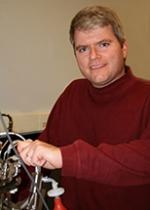May 31 2009
Jeffrey Catchmark sees the quest to unlock the mysteries of lignocellulose synthesis and assembly as one of the most important research pursuits of the next century.
 Jeffrey Catchmark, associate professor of agricultural and biological engineering in Penn State's College of Agricultural Sciences, is co-director of the new Center for Lignocellulose Structure and Formation.
Jeffrey Catchmark, associate professor of agricultural and biological engineering in Penn State's College of Agricultural Sciences, is co-director of the new Center for Lignocellulose Structure and Formation.
And the associate professor of agricultural and biological engineering in Penn State's College of Agricultural Sciences is on a mission to find the key. Co-director of the university's new Center for Lignocellulose Structure and Formation, Catchmark is determined to help answer the long-standing question of how our civilization can produce food, fuel and fiber more efficiently and sustainably.
The structure of cellulose -- the rigid material that makes woody plants hard and stiff and protects their sugars that scientists covet to produce biofuels -- holds the answer, he believes. "Even after decades of research, cellulose synthesis is not very well understood," Catchmark said. "We don't know how the cells assemble this chemical barrier to weather, insects and other organisms. The cell wall is very difficult to degrade."
Catchmark, center co-director Daniel Cosgrove, professor of biology in the Eberly College of Science, and other colleagues at the center will have substantial resources to aid their study of the molecular biology of cellulose. The U.S. Department of Energy recently awarded the center a $21 million, five-year "Energy Frontier" grant to learn more about the physical structure of the bio-polymers in plant cell walls and improve methods for converting plant biomass into fuel. The funding for this center is contained in the economic stimulus bill, the American Recovery and Reinvestment Act of 2009.
"Cellulose is the most abundant biopolymer on Earth," Catchmark pointed out. "More wood is used than all other materials, except those mined like the ingredients in concrete. If we could more efficiently use this fiber, it would have huge impacts. The question is, how can we better use the cellulose that we get from plants?"
The Center for Lignocellulose Structure and Formation will be one of few places where research is truly focused on unraveling the secrets of lignocellulose. "We believe we can answer the basic questions that to date no one has been able to answer," Catchmark explained. "We need to learn how cellulose is produced and how the biopolymers are assembled. If we know that, we think we can develop processes to disassemble it."
Disassembling plant walls is crucial, of course, because improving methods for converting plant biomass into fuel depends on breaking down the cellulose.
With vast agricultural and forest-based feedstocks, the United States is uniquely and competitively poised to capitalize on technical advancements relating to lignocellulosic materials, noted Nicole Brown, associate professor of wood chemistry, who is part of the center.
But the center - which also will sponsor collaboration with researchers at North Carolina State University and Virginia Polytechnic Institute and State University - is about more than biofuels, she pointed out. "Understanding these complex materials - specifically how proteins work to assemble the biopolymers -- is key to efficient utilization and technological breakthroughs," Brown said. "Furthering our understanding of renewable material synthesis and coupling this to nanotechnology is paramount to engineering composites and other value-added materials for the 21st century."
Other researchers involved in the center from the College of Agricultural Sciences include John Carlson, director of the Louis W. Schatz Center for Tree Molecular Genetics in the School of Forest Resources; Tom Richard, associate professor of agricultural and biological engineering and director of Penn State's Institutes of Energy and the Environment; Doug Archibald, research associate in the Department of Crop and Soil Sciences; and Virendra Puri, Distinguished Professor of Agricultural Engineering.
"We want to understand the role of the different components of plant cell walls," Puri said, "The hope is that once we understand this, we can design a better plant that will give us biofuel without having to waste or deal with other materials."
Puri doesn't expect any quick revelations. "It is a long-range kind of thing - our understanding will be a lot better in the coming years," he added. "Once we unlock the mystery of how the materials go together - how they are intertwined - and we can learn to take them apart, then the possibilities are vast."